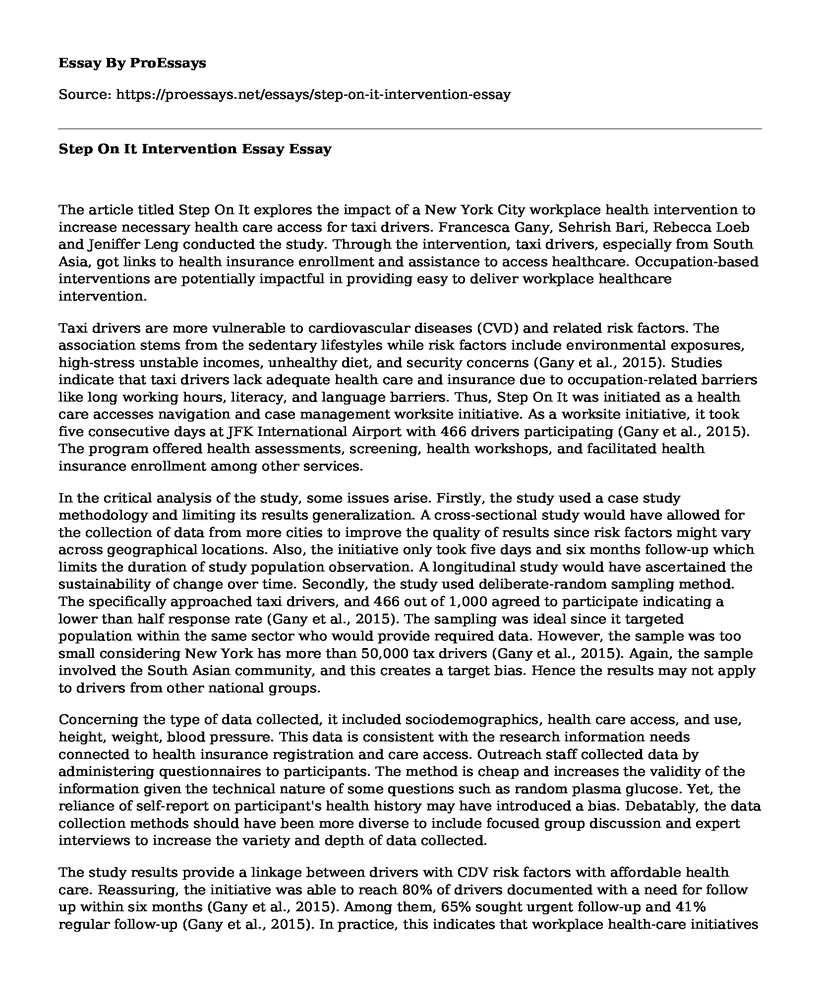The article titled Step On It explores the impact of a New York City workplace health intervention to increase necessary health care access for taxi drivers. Francesca Gany, Sehrish Bari, Rebecca Loeb and Jeniffer Leng conducted the study. Through the intervention, taxi drivers, especially from South Asia, got links to health insurance enrollment and assistance to access healthcare. Occupation-based interventions are potentially impactful in providing easy to deliver workplace healthcare intervention.
Taxi drivers are more vulnerable to cardiovascular diseases (CVD) and related risk factors. The association stems from the sedentary lifestyles while risk factors include environmental exposures, high-stress unstable incomes, unhealthy diet, and security concerns (Gany et al., 2015). Studies indicate that taxi drivers lack adequate health care and insurance due to occupation-related barriers like long working hours, literacy, and language barriers. Thus, Step On It was initiated as a health care accesses navigation and case management worksite initiative. As a worksite initiative, it took five consecutive days at JFK International Airport with 466 drivers participating (Gany et al., 2015). The program offered health assessments, screening, health workshops, and facilitated health insurance enrollment among other services.
In the critical analysis of the study, some issues arise. Firstly, the study used a case study methodology and limiting its results generalization. A cross-sectional study would have allowed for the collection of data from more cities to improve the quality of results since risk factors might vary across geographical locations. Also, the initiative only took five days and six months follow-up which limits the duration of study population observation. A longitudinal study would have ascertained the sustainability of change over time. Secondly, the study used deliberate-random sampling method. The specifically approached taxi drivers, and 466 out of 1,000 agreed to participate indicating a lower than half response rate (Gany et al., 2015). The sampling was ideal since it targeted population within the same sector who would provide required data. However, the sample was too small considering New York has more than 50,000 tax drivers (Gany et al., 2015). Again, the sample involved the South Asian community, and this creates a target bias. Hence the results may not apply to drivers from other national groups.
Concerning the type of data collected, it included sociodemographics, health care access, and use, height, weight, blood pressure. This data is consistent with the research information needs connected to health insurance registration and care access. Outreach staff collected data by administering questionnaires to participants. The method is cheap and increases the validity of the information given the technical nature of some questions such as random plasma glucose. Yet, the reliance of self-report on participant's health history may have introduced a bias. Debatably, the data collection methods should have been more diverse to include focused group discussion and expert interviews to increase the variety and depth of data collected.
The study results provide a linkage between drivers with CDV risk factors with affordable health care. Reassuring, the initiative was able to reach 80% of drivers documented with a need for follow up within six months (Gany et al., 2015). Among them, 65% sought urgent follow-up and 41% regular follow-up (Gany et al., 2015). In practice, this indicates that workplace health-care initiatives have the potential of increasing primary health care, especially for minority groups. Policy-wise, the study provides insights for implementation of accessible health care policies especially insurance targeting. Only 48% had health insurance, and 49% had no primary care provider (Gany et al., 2015). The research provides new information for overcoming occupation related barriers, especially for immigrant communities. Moving forward, the study suggests future studies to investigate specific health outcomes, which would be ideal in assessing whether workplace interventions can indeed reduce specific CDV events rather than just increasing access to health care.
Conclusion
In summation, it is possible to increase healthcare access using workplace interventions. The study focuses on the Step On It intervention that targeted taxi drivers with an intention to increase their enrollment in health care insurance and to guide them in accessing healthcare. The methodology was a case study that collected health-related data of participants using administered questioners. The results indicate that the participant's uptake for medical follow-ups is encouraging hence providing a model that can be scaled up to overcome workplace barriers and immigrant communities.
References
Gany, F., Bari, S., Loeb, R., & Leng, J. (2015). Step on it! Impact of a workplace New York City taxi driver health intervention to increase necessary health care access. American Journal of Public Health, 105(4), 786-792.
Cite this page
Step On It Intervention Essay. (2022, Jun 16). Retrieved from https://proessays.net/essays/step-on-it-intervention-essay
If you are the original author of this essay and no longer wish to have it published on the ProEssays website, please click below to request its removal:
- Food and Dietary Needs for the 21st Generation Essay
- Exposure to Chemicals in Plastic from Bottled Water: Annotated Bibliography
- Extreme Measures (film, 1996), pp. 263-265
- Exploration of a Shared Information System in Baylor Scott and White Health - Essay Sample
- Essay Sample on On-the-Job Training (OJT)
- Advanced Practice Nurses: Primary Care Status & Barriers - Essay Sample
- Essay Example on Public Policy: Authoritative Action to Deal With Social Problems







